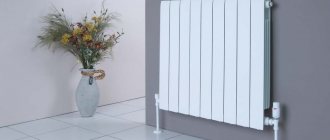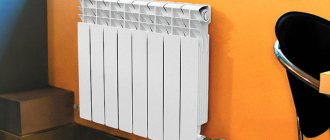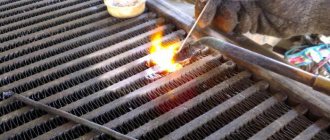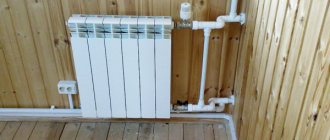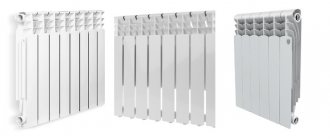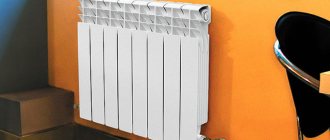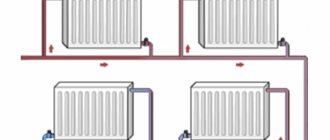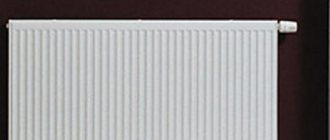When purchasing components for an autonomous heating system, batteries can account for up to 50% of the cost. Aluminum heating radiators will help reduce costs, since they cost approximately 30% less than their bimetallic counterparts and are comparable in cost to steel ones. However, the choice of this type of device must be taken responsibly and study all the pros and cons.
High-quality aluminum heating radiators provide excellent heat transfer, look attractive, and are easy to install and operate. At the same time, the technical characteristics of not all models are suitable for installation in apartment buildings and private buildings with a closed heating system.
What are aluminum radiators?
Radiators that are similar in design can have very different characteristics. This is due to manufacturing technology and the integrity of the manufacturer, who independently selects raw materials for their products.
Design and device
Aluminum radiators are a prefabricated structure made up of individual sections. Panel heating devices are not made from aluminum due to the properties of the material.
Most often on sale there are batteries assembled from individual elements already at the factory. The technological chain involves strength testing with maximum permissible pressure. Buying a ready-made battery of 4, 6, 8, etc. assembled sections, you are more likely to get a high-quality product.
Types of batteries by design
There are two types of batteries: collapsible and non-removable.
Collapsible sectional radiator
Non-separable model
In the first case, the sections are connected with threaded bushings, and sealing is carried out with silicone, rubber or paronite gaskets.
The joints are the weak link of the product:
- during heating/cooling cycles, depressurization of joints is possible due to regular changes in dimensions caused by thermal expansion;
- It is impossible to visually determine what material the gasket is made of.
Rubber gaskets can withstand system pressures of up to 6 atm and temperatures of up to 90 °C, which is only sufficient for individual heating systems in a private home. Paronite gaskets fully satisfy the requirements for reliability and durability for apartment buildings, but it is impossible to be sure that this particular design is used.
The advantage of collapsible radiators is the ability to replace a section if it is destroyed.
Monolithic (non-separable) radiators are resistant to pressure drops, since the individual sections are factory welded together. However, if there is a malfunction, the entire battery will have to be replaced. On the other hand, the work of a technician and the cost of a spare section may bring the cost of repair closer to the purchase of a new battery.
Comparison of parameters and qualities of bimetallic and aluminum heating radiators
Raw materials used
In almost all enterprises, radiators are produced on automated lines, eliminating the human factor. The quality of the product depends mainly on the raw materials used.
The best radiators are made from so-called highly purified primary aluminum, containing a minimum of impurities. To give the alloy the necessary properties, the following are added to it: magnesium, manganese, zirconium, scandium, which affect the individual properties of the metal. Radiator compositions should contain from 0.5 to 10% silicon. Its introduction prevents cracking under the influence of external factors (pressure and temperature).
In small enterprises, in order to reduce costs, they use secondary aluminum obtained by melting scrap. It is impossible to predict the exact chemical composition of the metal, the presence of additives and the properties of the alloy. It is not advisable to purchase Chinese-made products for installing batteries in apartment buildings. Such products are also used with caution in private buildings, where depressurization can lead to great material damage.
Comparison with radiators made of other metals
Let's consider the main characteristics of aluminum radiators against the background of other, no less popular in Russia, convectors made of other metals. For ease of perception of information, all information is presented as a comparative table.
The presented table makes it clear that in many performance indicators, aluminum radiators differ significantly from analogues made from other materials:
- The spread in temperature of the working fluid is approximately the same, but this condition will be interesting only if antifreeze is used as a coolant. In most residential buildings and apartments, the temperature of the water circulating in the system does not exceed 80-90°C.
- The magnitude of the operating pressures introduces a kind of scatter. Cast iron does not tolerate stretching well, so it has a low index. Steel is slightly higher, bimetal has the highest value.
- In terms of efficiency, aluminum radiators can be called optimal in terms of price-result ratio. They emit much less heat than copper ones, but they are also much cheaper.
- An equally important factor is the weight of the radiator. This issue is most relevant when designing a heating system for a building built from porous aerated concrete. Lightweight bimetal and aluminum will not put excessive stress on the bracket like their steel or cast iron counterparts. Also, as already mentioned, lower weight facilitates the process of transporting and installing equipment.
Choosing a suitable radiator Source oboiman.ru
Types of batteries by production technology
Radiators are manufactured using one of two methods:
- injection molding;
- extrusion of softened raw materials.
If everything is clear with casting technology, then the production of radiators using the extrusion method occurs using a different method.
On production lines, blanks of section ribs are separately obtained by pressing the softened alloy in special molding machines. Next, the ribs are welded to the collectors. By the presence of a seam at the joints, it can be determined that the battery is made by extrusion.
Welding seam indicating extrusion manufacturing. In cast radiators there are no seams between the collectors and fins.
Important! Extruded radiators are cheaper and have poorer technical characteristics compared to cast products. Because of this, sellers can mislead buyers by selling cheap (extrusive) goods at the price of cast ones.
Anodized radiators
Well-known manufacturers necessarily protect the internal cavities of the radiator, preventing the formation of hydrogen upon contact between aluminum and coolant. The phenomenon is dangerous due to an increase in pressure in the system and destruction of the battery housing, pipelines or parts of the heating boiler.
Technologically, protection is carried out by electrochemical anodizing in baths with special solutions. After processing, a film is formed on aluminum that is not subject to chemical interaction with the coolant. Anodized radiators are the best solution, but their cost is usually several times higher.
Bimetallic
The material from which bimetallic radiators are made consists of two metals. Such radiators have a frame made of iron tubes, covered with a duralumin shell made in the form of aluminum fins. They are installed in different heating systems of buildings of any number of floors. In the manufacturing process of bimetallic radiators, the metals used in them are not welded together, but are joined under high pressure, which achieves high structural strength. Thanks to this, water circulating through a steel tube does not lead to corrosion of aluminum, and the aluminum from which the shell is made ensures effective heat transfer to the heated space. The service life of such radiators declared by the manufacturers is fifty years.
Comparison of technical characteristics
Characteristics important for comparative analysis are collected in the table.
| Characteristic | Production method | |
| Cast | Extrusive | |
| Heat transfer of 1 section for radiators with a section height of 500 mm, W* | 80–210 | up to 200 |
| Working pressure, atm | 10–16 | 6–10 |
| Crimping pressure, atm | 15–20 | 10–15 |
| Breaking pressure, atm | 60–100 | 40–50 |
| Operating coolant temperature, °C | up to 120 | up to 100 |
| Manufacturer's warranty, years | 10–25 | 5–10 |
*Heat transfer is measured at a temperature difference between the coolant and air in the room of 70 oC.
Editor's Choice
Aluminum radiator Oasis Al 500/96 (average price 2,600 rubles)
Aluminum radiator Oasis Al 500/96. Photo: yandex.market.ru
Oasis radiators are sleek, lightweight, compact and do not require painting. They are produced in a modern way - the “injection molding” method, each section of the radiator is poured out entirely and a bottom (sump) is welded to the finished section. They provide rapid heat transfer to the air in a heated room. Stylish design fits perfectly into any space.
Characteristics
| Type | sectional |
| Design | wall-mounted |
| Vertical design | No |
| Connection | lateral |
| Material | aluminum |
| Center distance | 500 mm |
| Maximum operating temperature | 110°C |
| Maximum power | 532…1596 W |
| Maximum working pressure | 16 bar |
| Crimping pressure | 24 bar |
Advantages and disadvantages
High-quality assembly, stylish design
Poor quality paint job
show more
Aluminum radiator Lammin Eco AL (average price 2,500 rubles)
Aluminum radiator Lammin Eco AL. Photo: yandex.market.ru
This device is a heating structure that is designed for heating apartments, private houses, offices and shops. Radiator sections are made from high-quality aluminum alloy using modern high-pressure casting technology. For longer service life and additional protection against rust, their interior is coated with zirconium. Small debris and impurities contained in the water practically do not settle on the surface.
Characteristics
| Type | sectional |
| Design | wall-mounted |
| Connection | lateral |
| Material | aluminum |
| Center distance | 500 mm |
| Maximum operating temperature | 110°C |
| Maximum power | 1140 W |
| Maximum working pressure | 16 bar |
| Crimping pressure | 24 bar |
Advantages and disadvantages
Low price, multi-layer coating
Some buyers complain about leaks in the thread area
show more
Aluminum radiator Tropic Al 500 (average price 2,100 rubles)
Aluminum radiator Tropic Al 500. Photo: yandex.market.ru
The Tropic radiator sections have rounded shapes without any sharp corners or edges. This feature allows you to install the device in rooms with increased safety requirements. A coating with a high content of fluorine and zirconium reliably protects the internal and external surfaces of the radiator. Die-cast aluminum alloy containing silicon and titanium additives, giving the product additional strength and corrosion resistance.
Characteristics
| Type | sectional |
| Design | wall-mounted |
| Vertical design | No |
| Connection | lateral |
| Material | aluminum |
| Center distance | 500 mm |
| Maximum operating temperature | 110°C |
| Maximum power | 187…2244 W |
| Maximum working pressure | 18 bar |
| Crimping pressure | 25 bar |
Advantages and disadvantages
High-quality damage protection, reliability
For installation, you need to purchase additional parts that are not included in the kit.
show more
Advantages and disadvantages of aluminum radiators
The positive and negative aspects of aluminum radiators should be assessed according to the consumer qualities that are subjectively perceived by the consumer and the technical characteristics that are important for installation companies and operating organizations.
Table. Assessment of consumer properties of aluminum radiators.
| Advantages | Flaws |
| The price is lower compared to bimetallic analogues | Presence of low-grade products on sale |
| Attractive appearance, various designs, incl. factory painted in different colors (delivery upon pre-order) | The need for periodic bleeding of formed gases |
| Good heat dissipation | Restriction on use in multi-family buildings |
| Minimal maintenance - convection currents prevent dust from accumulating on the edges of the sections | The likelihood of leaks and the need to repair radiators assembled from separate sections |
| Availability of control devices | |
| Low inertia, heating begins immediately after the coolant is supplied. |
Detailed comparison of steel and aluminum radiators
Table. Features of design and technical characteristics.
| Advantages | Flaws |
| The characteristics of products from well-known manufacturers allow radiators to be used in any conditions | Impossibility of using inexpensive low-quality products in apartment buildings |
| Light weight, allowing installation on non-permanent partitions | Mandatory equipment for automatic air vents, even for anodized models that lose their properties over time |
| Standardized dimensions allowing you to select the size to fit the existing supply pipe system | |
| Availability of models with side, bottom and diagonal connections, which is important when installing a heating system | |
| Small internal volume of sections, reducing the amount of coolant in the system |
Designer radiators
Among the abundance of types of heating radiators, there is also its own elite in the form of designer radiators. In addition to their direct purpose of heating rooms, such radiators can also decorate the interior. They can have different sizes and shapes and different colors. Aluminum, steel, and even stones can be used in these radiators. Cast iron radiators are also not deprived of attention by designers; they are often decorated with ornaments that are made in various ways, which are based on cast iron. Thanks to the designer’s imagination, such radiators can differ not only in different shapes, but also be made in the form of a stair railing, a screen, a column, and even a mirror frame, or be another unexpected element of the interior. Of course, the cost of such delights is extremely high.
The article was written for the site.
Tags:Heater, heating
How to choose aluminum radiators
Minimum power
To accurately calculate the total thermal power, specialists carry out a thermal engineering calculation, which takes into account:
- long-term average annual climate indicators in the region of residence;
- thermal conductivity of building materials of walls, ceilings and building foundations;
- quality of insulation;
- glazing area, its characteristics, frame material, number of glasses in the package and cardinal directions where the windows face;
- area and volume of premises.
Losses are taken into account depending on the method of installation of radiators. For example, installation under a window sill reduces productivity by 4%, and in a wall niche by 7%. The screen has a similar effect on heat transfer, reducing it by 7–8%.
Changes in the thermal power of the radiator depending on the placement and presence of a screen.
Below we will present a calculator for such a calculation, but first we suggest you familiarize yourself with a simpler and more common method.
In most cases, for buildings made in accordance with Building Codes and Regulations, it can be assumed that heating one square meter of premises will require a thermal power of 100 W. Sometimes they are calculated by volume, then an indicator of 50 W/m3 is chosen.
Example. The area of the house is 100 m2, and the ceiling height is 2.7 m. In this case, you will need to install radiators with a total power of 10 kW.
Next, for the calculation, we study the product passport, which indicates the power of one section, for example, 180 W. Thus, it is necessary to divide the required minimum power by the performance of one section: 10,000/180 = 55.5 sections.
There is another way: it is believed that heating 2 m2 requires 1 radiator section. If we divide the area of 100 m2 by 2, we get approximately the same figure - 50 sections.
Advice! To avoid having to heat the coolant in a private home to a temperature of 80-95 oC, we recommend providing a 10% reserve for the power supplied by the batteries. This will allow you to operate the boiler and all elements of the heating system in a “gentle” mode, which will significantly extend the service life of each element.
Operating pressure
Almost any commercially available aluminum radiators are suitable for installation in private homes.
The working pressure in individual heating systems of a 2-3 storey building is limited by the characteristics of the boilers; they are designed for a pressure of up to 3.5 atm.
In private homes, systems are filled with clean water or antifreeze; this eliminates chemical reactions; the walls of radiators do not thin out over time, which means they will not collapse due to increased pressure.
In apartment buildings, a working pressure of up to 8-10 atm is created to circulate the coolant. It is necessary to raise the coolant to the upper floors and overcome the hydraulic resistance to fluid flow. At the time of annual pressure testing, the pressure is increased to 15 atm, identifying possible coolant leaks, and during water hammer, up to 30 atm can be applied to the radiators.
Based on these parameters, heating radiators are selected
Important! For apartment buildings, radiators are purchased that are designed for an operating pressure of 10-16 and pressure testing up to 20 atm.
Center distance
The center distance must be known for ease of installation, especially when replacing radiators. Parameter is important
(see photo below), when the supply pipe is connected to the upper collector of the battery, and the coolant is removed from the lower one. If the distance does not match, then additional turns will have to be made, which worsens the appearance of the structure.
Diagonal connection.
In most cases, the piping pipes are located at a distance of 350 or 500 mm. Based on this, radiators are purchased; there is no need to weld or solder additional turns. The parameter is usually indicated in the name of the convector, for example, Royal Thermo Revolution 500. The value 500 is the center distance.
With a bottom or side bottom connection, take into account the possibility of connecting pipes to the radiator from the desired side; the center-to-center distance in this case does not matter.
Dimensions
The geometric dimensions of radiators directly affect heat transfer (power). However, there are restrictions during installation:
- the distance from the floor should not be less than 70-100 mm;
- the distance between the battery and the window sill is chosen to be at least 80 mm;
- 80 mm is left to the side walls, and about 30 mm to the wall of the house.
If the requirements are not met, convection will deteriorate, which reduces the performance of the device.
Exact installation recommendations are indicated in the operating instructions or data sheet for a specific model.
Detailed diagram from the instructions using the Royal Thermo Vittoria as an example.
When purchasing, take into account the thickness and width of the assembly, since if the window sill is not wide, the radiator will extend beyond it, which will worsen the design of the room.
Tubular batteries high
- Providing information by the Client:
1.1.
When registering on the website home-heat.ru (hereinafter referred to as the “Site”), the Client provides the following information: Last name, First name, email address. When placing an Order, the Client can provide the following information: last name, first name, patronymic of the recipient of the Order, address for delivery of the Order, contact phone number.
1.2. By providing his personal data, the Client agrees to their processing (up to the Client’s withdrawal of his consent to the processing of his personal data) (hereinafter referred to as the “Seller”), in order for the Seller and/or its partners to fulfill their obligations to the client, sell goods and provide services, providing reference information, as well as for the purpose of promoting goods, works and services, and also agrees to receive advertising and informational messages and service messages. When processing the Client’s personal data, the Seller is guided by the Federal Law “On Personal Data”, the Federal Law “On Advertising” and local regulatory documents.
1.2.1. If the Client wishes to clarify his personal data, block or destroy it if the personal data is incomplete, outdated, inaccurate, illegally obtained or is not necessary for the stated purpose of processing, or if the client wishes to withdraw his consent to the processing of personal data or eliminate unlawful actions of EKON LLC in relation to his personal data, then he must send an official request to the Seller in the manner prescribed by the EKON LLC Policy regarding the processing of personal data.
If the Client wishes to delete his account on the Site, the Client contacts us at the following address with a corresponding request. This action does not imply the withdrawal of the Client’s consent to the processing of his personal data, which, according to current legislation, occurs in the manner provided for in paragraph 1 of this paragraph.
1.3. Use of information provided by the Client and received by the Seller.
1.3.1 The Seller uses the data provided by the Client during the entire period of the Client’s registration on the Site for the purposes of:
- registration/authorization of the Client on the Site;
- processing the Client's Orders and to fulfill its obligations to the Client;
- to carry out activities to promote goods and services;
- assessment and analysis of the Site’s operation;
- determining the winner in promotions conducted by the Seller;
- analyzing the Client’s purchasing characteristics and providing personal recommendations;
- informing the client about promotions, discounts and special offers through electronic and SMS newsletters.
1.3.2. The Seller has the right to send advertising and informational messages to the Client. If the Client does not wish to receive advertising and informational messages from the Seller, he must change the appropriate subscription settings in the appropriate section of his Personal Account. From the moment the specified settings are changed, receiving the Seller’s mailings is possible within 3 days, which is due to the peculiarities of the operation and interaction of information systems, as well as the terms of agreements with contractors who send advertising and informational messages in the interests of the Seller. The Client’s refusal to receive service messages is impossible for technical reasons. Service messages are sent to the email address specified when registering on the Site, as well as via SMS messages and/or push notifications and through the Customer Service Service to the phone number specified during registration and/or when placing an Order, about the status Order, items in the Client’s basket and/or added by the Client to “Favorites”, as well as the Seller’s request to leave a review of the purchased Product.
- Provision and transfer of information received by the Seller:
2.1. The Seller undertakes not to transfer information received from the Client to third parties. It is not considered a violation for the Seller to provide information to agents and third parties acting on the basis of an agreement with the Seller to fulfill obligations to the Client and only within the framework of the agreements. The transfer by the Seller to third parties of data about the Client in an impersonal form for the purpose of assessing and analyzing the operation of the Site, analyzing the Client’s purchasing characteristics and providing personal recommendations is not considered a violation of this clause.
2.2. The transfer of information in accordance with reasonable and applicable requirements of the legislation of the Russian Federation is not considered a violation of obligations.
2.3. The seller has the right to use “cookies” technology. Cookies do not contain confidential information and are not transferred to third parties.
2.4. The Seller receives information about the IP address of the visitor to the Website www.home-heat.ru and information about the link from which Internet site the visitor came from. This information is not used to identify the visitor.
2.5. The Seller is not responsible for the information provided by the Client on the Site in a publicly accessible form.
2.6. When processing personal data, the Seller takes necessary and sufficient organizational and technical measures to protect personal data from unauthorized access to it, as well as from other unlawful actions in relation to personal data.
2.7. More complete information about the policy of ECON LLC regarding the processing of personal data is provided here.
- Storage and use of information by the Client
3.1. The Client undertakes not to disclose to third parties the login and password used by him for identification in the home-heat.ru online store.
3.2. The Client undertakes to ensure due diligence when storing and using the login and password (including, but not limited to: using licensed anti-virus programs, using complex alphanumeric combinations when creating a password, not making a computer or other equipment with information entered on it available to third parties). Client login and password, etc.)
3.3. If the Seller has suspicions regarding the use of the Client’s account by a third party or malicious software, the Seller has the right to unilaterally change the Client’s password.
The best known manufacturers and models: characteristics and prices
The most widely used brands are:
- Oasis . The Chinese concern was founded in 2006, so the factories are equipped with modern equipment, which guarantees quality. Some products are produced under licenses from Western European companies.
- Monlan , a Chinese company focusing on the market of the Russian Federation and some CIS countries. Economy class products are intended only for private homes, since the manufacturer saves on materials, the walls of the sections are thin and are not designed for high pressure. The reliability of work in private homes is not satisfactory. When purchasing, check the appearance - the color of the radiators may vary even in the same batch.
- Purmo , Finland, a recognized leader in the production of heating equipment.
- Tessen is one of the best Chinese manufacturers. The walls of the radiators are sufficiently thick; the technical characteristics of some models allow installation in apartment buildings.
- Global Radiatori , the concern's factories are located in European countries, cheap products are delivered from China.
- IPS , Italy. Produces radiators of the highest quality. Factories are located in Italy and Slovakia. The price of products is high, which limits the distribution of products.
- Rifar , Russia. The production is located in the Orenburg region. The manufacturer insures its products against destruction, but to obtain it, the installation of products must be carried out by a specialized organization.
- Royal Thermo , Russia. All products undergo quality control; aluminum radiators are necessarily processed using anodizing technology.
- Radena , Italy. All production is located in Italy, which gives additional confidence in quality. If other countries are indicated in the passport, this means counterfeit products.
- Mandarino , a Russian company operating under an Italian license. High quality is a distinctive feature of the products.
The most in demand are white radiators with a number of sections from 4 to 10 and with an interaxial distance of 350 or 500 mm - these are the products that are on display in construction supermarkets.
How to actually choose the cheapest heating radiators on the market
Below are the models that are leaders in sales and consumer ratings.
Royal Thermo Biliner Alum 500
The plant of the Russian company is located in the Vladimir region. The manufacturer draws attention to the unusual aerodynamic shape of the products, developed by the Italian company IPG Design Studio. Additional fins provide high performance. The center distance of the model is 500 mm. The gaskets are made of cotton with the addition of silicone and graphite, which allows them to withstand coolant temperatures up to 130 °C. Dimensions: 580x80x87 mm.
Painting occurs in 7 stages, which ensures the stability of the layer for the entire period of operation. The warranty for the model is 10 years. Royal Thermo Biliner Alum 500 is one of the best aluminum radiators for a private home and apartment.
Royal Thermo Revolution 500
Radiators of the series are presented only in white. The wave-like shape of the ribs ensures increased convection of air flows.
The paint is completely safe and is highly resistant, so the series radiators can be installed in bedrooms and children's rooms, as well as in wet areas. Dealers are located in dozens of cities.
STOUT BRAVO 500
A series of Italian radiators with a center distance of 500 mm and side connections, painted in RAL9010 and RAL9016 colors. The manufacturer notes the simple installation of the radiator and the availability of control valves, since the connecting dimensions are standard for similar products. The aluminum body provides low inertia - the sections quickly heat up when the boiler is turned on.
An important condition set by the manufacturer: the quality of the coolant must meet the requirements of SO-153-34.20.501-2003, which is difficult to achieve for houses connected to old heating systems. The warranty may not apply if it is proven that the requirements of the document have not been met.
Global VOX R 500
Radiators are produced by an Italian company founded in 1971. The model was developed taking into account Russian conditions (low water treatment of the coolant and pressure drops in the system).
Heat transfer measured at a difference in coolant and air temperatures of 50°C is 181 watts/section, and at a difference of 70°C - 276 W, which is the best indicator for devices of similar dimensions.
Rifar Alum 500
The line includes radiators of the same shape, but different in axial distance. Reliability is achieved by milling the end of the section for a specially designed gasket. The locking connection is patented by the manufacturer. Radiators with a number of sections from 4 to 14 are commercially produced.
The Alum series includes Ventil types for bottom connection. Rifar Alum Flex – radiators with a radius of curvature for installation along rounded walls.
Radena 500
The radiator was designed by Italian designers and has an oval channel section for coolant circulation, which increases the contact surface area and, accordingly, the heat transfer of the section, amounting to 195 W.
ROMMER Al Optima 500
The batteries are produced by a Russian brand at a Chinese factory. Quality is ensured by automatic production lines and careful output control of all product parameters. Model color is white.
Features of the model: wall thickness 1.8 mm, anti-corrosion treatment of internal surfaces, two-stage painting with a mandatory primer.
Among the disadvantages are the low heat transfer of one section - 133 W and the maximum coolant temperature of 110 °C.
Mandarino 500
The peculiarity of the product is that the series is assembled from square or round pipes without fins and has a one-piece design with anodic oxidation of surfaces. The products look unusual and elegant.
Review of popular models
In Russia, tall radiators are only gaining popularity. Their production is gradually being established. But consumers prefer products from foreign manufacturers, who are far ahead in technology and design. Imported units are distinguished by modern style, high efficiency, reliability and durability.
Kermi
Elegant flat panel Kermi Verteo units, produced in Germany, save not only energy, but also space, and therefore are becoming increasingly in demand. New technology with an innovative twist, Therm X2 is a progressive approach to creating a microclimate in modern conditions.
The products of this brand have a number of advantages:
- heats up 25% faster than similar models;
- saves energy up to 11%;
- The intensity of thermal radiation reaches 100%;
- height up to 3 meters;
- 5 year warranty.
The cost of Kermi panels varies from 260 to 920 euros, depending on the dimensions and row of the structure.
Guardo
Italian heating devices have a height of 1 meter. They were developed taking into account the climatic conditions of Russia. The minimum number of sections is 4, the maximum is 40. Installation in multi-storey buildings is allowed. Mounting type: floor or wall. Construction depth from 65 mm (two-pipe) to 215 mm (6-pipe).
The devices can operate on both water and antifreeze, which is very convenient. If the owners of a private house leave for a long time in winter, they do not have to worry that the system will defrost. Antifreeze does not freeze even at -40 °C. Connection type: side or bottom. Price - from 6 to 65 thousand rubles, depending on the number of sections. 10 year warranty.
Purmo
The Finnish manufacturer offers electric vertical radiators Delta Electric with a height of 1500 and 1800 mm, but they can make any size up to 3 meters to order. The product can be painted in the desired color. The heating element is equipped with a thermostat and an auto-shut-off timer.
The Delta Electric radiator is wall mounted and has the following technical parameters:
- width - 300 or 600 mm (6 or 12 sections);
- depth - 63 mm (2-pipe) and 101 mm (3-pipe);
- temperature adjustment from 30 to 70 °C;
- power - from 0.3 to 2 kW;
- power source - household socket with voltage 220 V;
- 10 year warranty.
The unit is equipped with a digital display, a connection box for hidden wiring, a towel rack and hooks. Price - from 38 to 68 thousand rubles.
Prices: summary table
| Model | Heat transfer per section, Vit | Working pressure, atm | Breaking pressure, atm | Average price per section | Price for 1,000 W of power |
| Royal Thermo Biliner Alum 500 | 175 | 16 | 48 | 760 | 4 300 |
| Royal Thermo Revolution 500 | 170 | 20 | 50 | 850 | 5 000 |
| Global VOX R 500 | Up to 276 | 16 | 48 | 720 | 5 000 |
| Rifar Alum 500 | 186 | 15 | 50 | 750 | 4 000 |
| Radena 500 | 195 | 15 | 40 | 960 | 4 900 |
| ROMMER Al Optima 500 | 133 | 12 | 24 | 388 | 3 000 |
| Mandarino 500 | 210 | 15 | 25 | 1600 | 7 000 |
When choosing aluminum radiators, we primarily focus on technical characteristics and operating conditions. The right choice will allow you to avoid troubles in the form of structural destruction and flooding of premises, which can result in high repair costs.
Installation recommendations
In order for the installed radiator to effectively perform its function, you must adhere to certain installation rules.
The way the batteries are located is also important:
- distance from the device to the wall - from 2 to 5 cm;
- distance from the floor to the device - from 10 to 12 cm;
- the distance from the top to the window sill is about 10 cm.
When installing equipment, shut-off and control equipment must be provided at the inlet and outlet. This will allow you to manually or automatically (if there are thermostatic valves) regulate the heating temperature. This is also done so that the batteries can be disconnected later, for example, if they need to be disassembled, washed or replaced with new ones. If necessary, if a leak appears, so as not to completely replace the equipment, it can be soldered.
In multi-storey buildings, heating devices are most often installed using a single-pipe system. But such a system does not provide temperature control devices.
When installing batteries, under no circumstances should they be hung on pipes. The device is mounted to the wall in such a way that the hooks of the brackets are located between the sections, and its lower part rests on the fasteners. To prevent future leaks, the connecting surfaces do not need to be cleaned.
While the device is being filled with coolant, the shut-off and control equipment must open smoothly, otherwise a water hammer may occur. Before installing radiators, each element of the system must be thoroughly washed. Do not use products that contain alkali.
For each aluminum radiator, an automatic device or manual valve should be provided to bleed air. During the work, you must adhere to the instructions that come with the device.
How to connect
Aluminum radiators are suitable for both two-pipe and single-pipe wiring. In the first case, the connection of the supply pipe and the outlet pipe occurs in parallel; they are independent of each other and are connected through the final device of the heating system.
With single-pipe wiring, the coolant passes through one pipe sequentially through all radiators, gradually cooling down.
There are several schemes for connecting aluminum devices:
- diagonal;
- lateral;
- lower.
All schemes differ from each other not only in the installation method, but also in the quality of heat transfer.
- Diagonal. The most effective and common installation method is a diagonal connection (heat loss is no more than 2%). The method is well suited for radiators with a large number of sections. The supply pipeline is connected to one of the upper pipes. The outlet pipe is connected to the bottom one from the opposite side. This piping method is used mainly for two-pipe heating systems, because with a one-pipe system the coolant noticeably loses heat as it passes through each radiator. The disadvantage of such a connection lies in its aesthetic unattractiveness, since the pipes run along the upper edge of the heating devices.
- Lateral (unilateral). The scheme is similar to a diagonal connection: the hot water supply pipe is on top, the outlet pipe is on the bottom, but the installation is made to pipes located on one side. It is important not to mix up the pipes or swap them. This method is more often used in multi-storey buildings with small radiators. It is not suitable for devices with more than 15 sections, since with a larger number, the far (opposite to the connection point) side of the unit does not heat up well.
- Lower. This connection is made to the pipes located at the bottom of the heating device. This installation scheme allows you to hide the heating system pipes under the floor, which is beneficial from a design point of view. But the heat transfer with such an installation is much lower (about 15% less than the rated power of the radiator).
Installation process
In general, you should entrust the work of installing a radiator to a qualified specialist. But, knowing all the features, you can control the process yourself.
The installation process consists of several stages:
- Assembly. It is carried out before the entire heating system is installed. At the outer section, auxiliary equipment is installed: plugs, plugs, locking devices, and so on.
- Determination of attachment points. Recommendations for battery placement should be strictly followed to ensure maximum performance of the device.
- Installation of brackets. These elements are fixed with dowels. If desired, a cement solution is used as a fastening material.
- Battery installation. The mounting hooks must be installed so that they are located between the sections of the device. The lower parts have their own holders to prevent sagging. It is very important that the radiator is installed strictly horizontally, for which you need to use a level.
- Connection to the system. Depending on how the sections of the device are located, the heat pipes can be connected by one or two connections. The supply pipes must have a valve or thermostat. In order for all sections to warm up evenly, it is imperative to bleed the remaining air from the system.
Installation of heating equipment is not difficult. If the owner of the house does not have enough experience, it is recommended to seek help from specialists, which will guarantee long and efficient operation of the heating system. Learn how to insulate a wooden floor by following the link.


